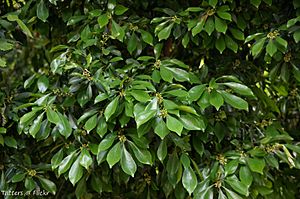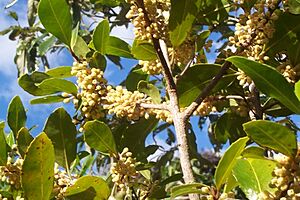Rapanea variabilis facts for kids
Quick facts for kids Rapanea variabilis |
|
|---|---|
 |
|
| Scientific classification | |
| Kingdom: | |
| (unranked): | |
| (unranked): | |
| (unranked): | |
| Order: | |
| Family: | |
| Genus: |
Rapanea
|
| Species: |
R. variabilis
|
| Binomial name | |
| Rapanea variabilis (R. Br.) Mez
|
|
| Synonyms | |
|
|
The Rapanea variabilis, also known as the muttonwood or variable muttonwood, is a type of tree found in eastern Australia. You can find it growing from near Milton in southern New South Wales all the way up to the McIlwraith Range in far northern Queensland.
This tree often grows at the edges of different kinds of rainforests. These include tropical, sub-tropical, warm temperate, and even rainforests right by the coast (called littoral rainforests).
Contents
What the Muttonwood Tree Looks Like
The muttonwood is a small tree, usually growing up to about 15 metres (about 50 feet) tall. Its main stem can be as wide as 50 centimetres (about 20 inches). It's easy to spot because of its thick, dark green leaves and its pretty blue fruits.
Trunk and Bark
The tree's trunk is usually straight and round. The bottom of the trunk doesn't have large, spreading roots (called buttresses). The bark is grey or brown and feels a bit like cork. It's rough with different marks, like horizontal lines and vertical cracks.
Leaves
The leaves of the muttonwood tree are very close to the branches, with stalks less than 5 millimetres long. They grow one after another along the stem. On young plants, the leaves have small teeth along their edges. Older leaves have wavy edges and feel quite stiff. They are shaped like a reverse spearhead, oblong, or egg-shaped, and are usually 3 to 8 centimetres long. They don't usually have a sharp point at the tip. You can easily see the leaf veins on both the top and bottom surfaces of the leaves.
Flowers and Fruit
Cream-coloured flowers grow in small groups at the ends of the branches. Each flower is only about 2 millimetres long and sits on a stalk about 4 millimetres long. The muttonwood usually flowers in July and August.
The fruits are blue or violet and ripen between November and December. They are small, round fruits, about 4 to 6 millimetres wide, and are called drupes (like a cherry or peach, with a hard pit inside).
Reproduction and Animals
Birds like the Lewin's honeyeater and the rose-crowned fruit dove enjoy eating the muttonwood's fruit. If you plant fresh seeds, they usually sprout easily. It's a good idea to remove the fleshy part around the seed (called the aril) before planting to help them grow better.
See also
 In Spanish: Myrsine variabilis para niños
In Spanish: Myrsine variabilis para niños
Further Reading
- Rainforest Trees of Mainland South-Eastern Australia by G. Floyd


